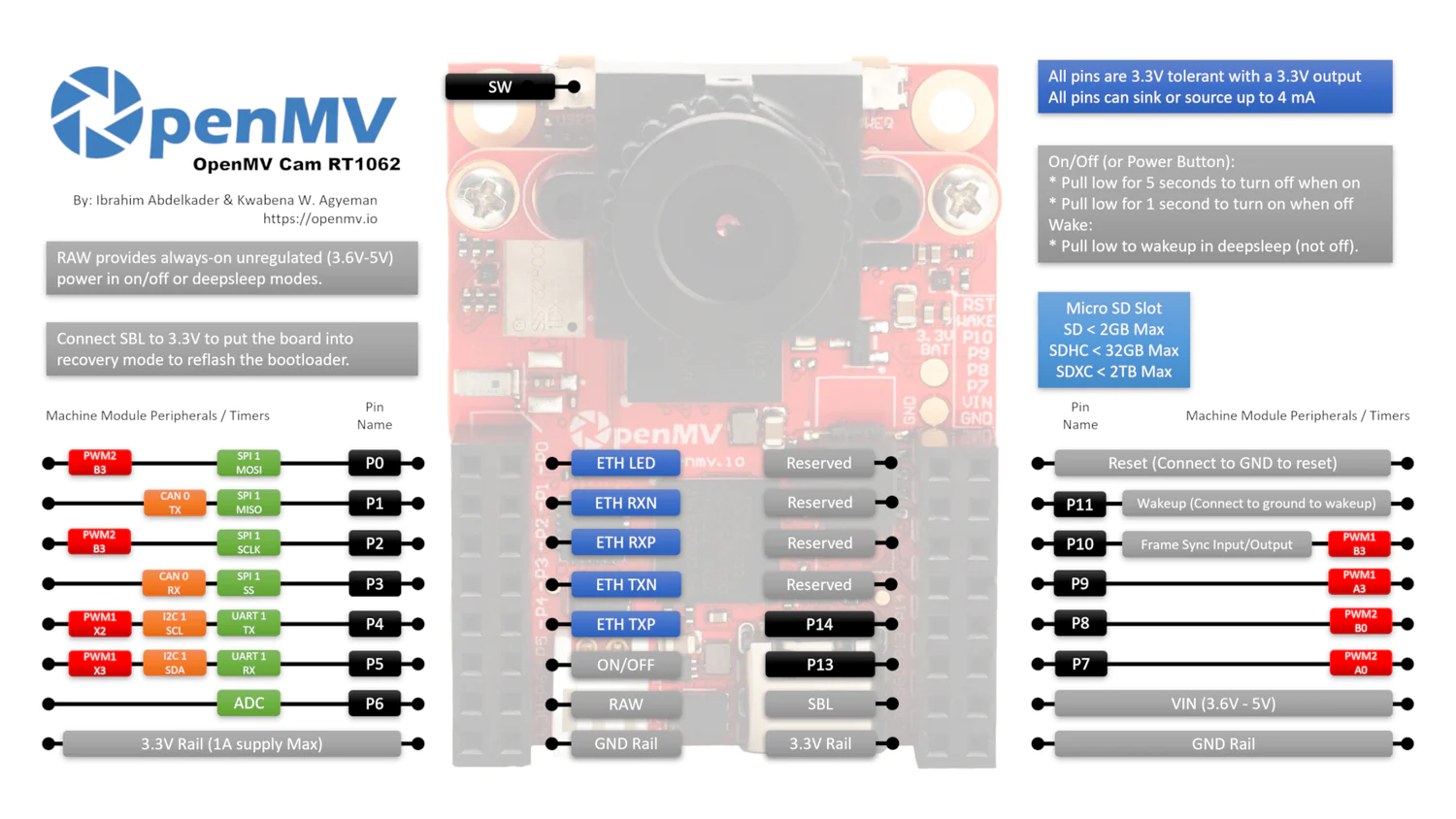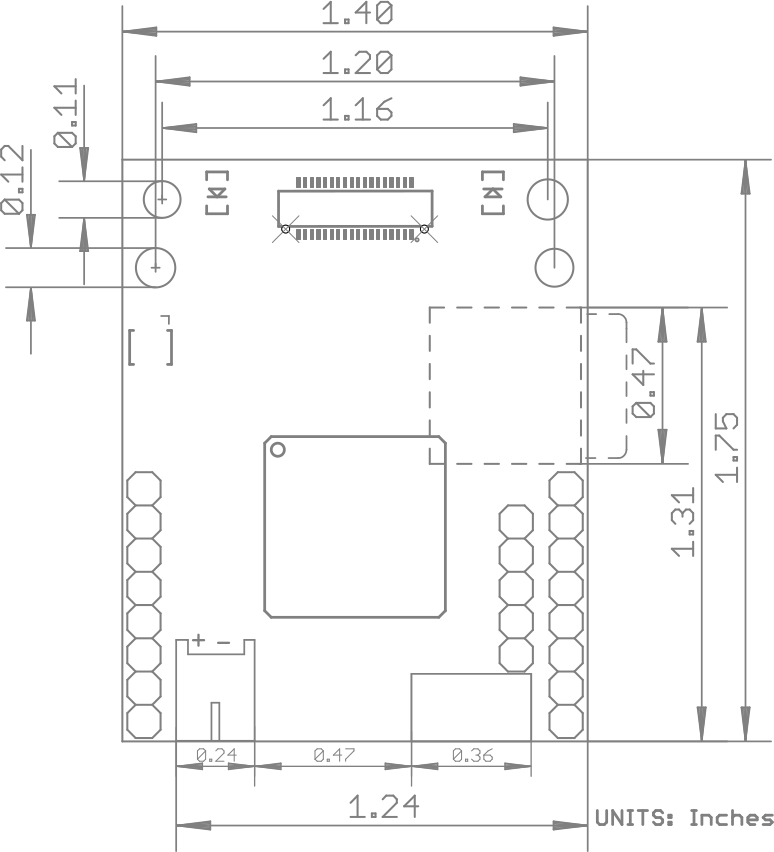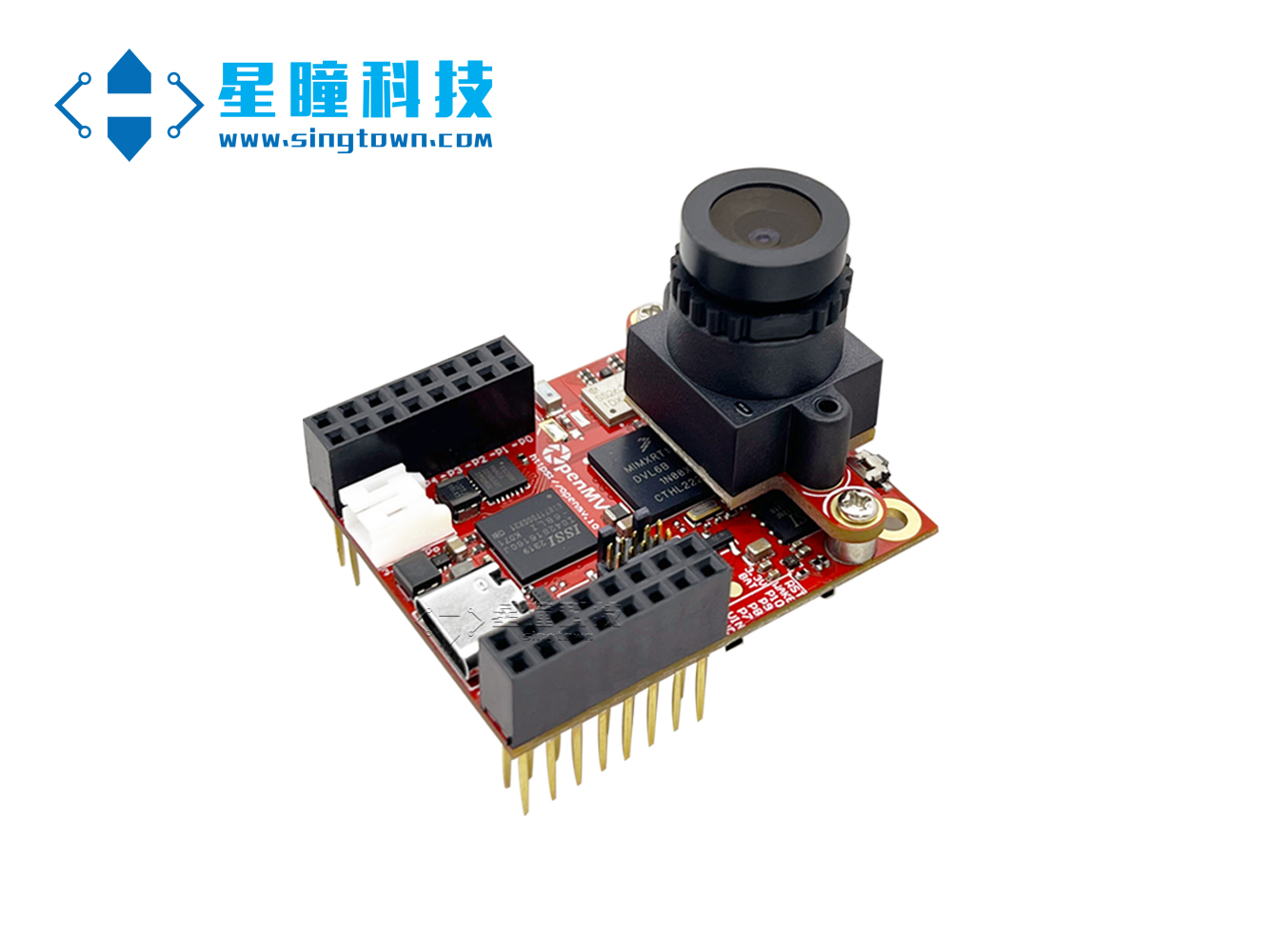OpenMV Cam RT1062
$120.00
The OpenMV Cam is a small, low power, microcontroller board which allows you to easily implement applications using machine vision in the real-world.
If you need to connect to Ethernet, apply it to industry or directly integrate it into enterprise products, need WiFi and use more pins at the same time, need integrated power charge and discharge management, accurate RTC time, and user and power buttons, then OpenMV RT1062 is your choice~
Home Page:http://openmv.cc
Buy OpenMV Cam and accessories on Amazon or Aliexpress (shipping global):
Amazon : https://www.amazon.com/shops/OpenMV-SingTown
Aliexpress : https://openmv.aliexpress.com
Description
Description
The OpenMV Cam is a small, low power, microcontroller board which allows you to easily implement applications using machine vision in the real-world. You program the OpenMV Cam in high level Python scripts (courtesy of the MicroPython Operating System) instead of C/C++. This makes it easier to deal with the complex outputs of machine vision algorithms and working with high level data structures. But, you still have total control over your OpenMV Cam and its I/O pins in Python. You can easily trigger taking pictures and video on external events or execute machine vision algorithms to figure out how to control your I/O pins.
The OpenMV Cam features:
- The RT1062 ARM Cortex M7 processor running at 600 MHz with 32MBs SDRAM + 1MB of SRAM and 16 MB of program/storage flash. All I/O pins output 3.3V and are 3.3V tolerant. The processor has the following I/O interfaces:
- A high speed USB-C (480Mbs) interface to your computer. Your OpenMV Cam will appear as a Virtual COM Port and a USB Flash Drive when plugged in.
-
1.5A current limited.
- With EMI Filtering and TVS protection.
-
- A μSD Card socket capable of 25MB/s reads/writes which allows your OpenMV Cam to take pictures and easilypull machine vision assets off of the μSD card.
- With EMI Filtering and TVS protection.
-
A SPI bus that can run up to 60Mb/s allowing you to easily stream image data off the system to either the LCD Shield or another microcontroller.
-
An I2C Bus (up to 1Mb/s), CAN Bus (up to 1Mb/s), and an Asynchronous Serial Bus (TX/RX, up to 20Mb/s) for interfacing with other microcontrollers and sensors.
- A 12-bit ADC (3.3V Tolerant).
-
Three I/O pins for servo control.
-
One I/O pin for frame sync/triggering (or servo control).
- An onboard RTC which keeps running when the system is in low-power mode (the system draws less than 30uA in low-power mode).
-
One I/O pin for low power wakeup.
-
There is also a pin for device power button ON/OFF support.
-
- Interrupts on all I/O pins (there are 14 I/O pins on the board).
-
With EMI Filtering and TVS protection.
-
-
A user controllable/dimmable RGB LED.
-
Another RGB LED for Charging, USB Power, VIN Power indication.
-
32 MB of external 16-bit SDRAM clocked at 160 MHz for 320 MB/s of bandwidth.
-
16 MB of program/storage quadspi flash clocked at 133 MHz in 4-bitSDR mode for 66MB/s of bandwidth (read speed).
-
A 12-bit X/Y/Z accelerometer (2/4/8g) centered underneath the camera module.
- Onboard WiFi (a/b/g/n – 11/54/65 Mb/s) and Bluetooth (v5.1 – BR/EDR/BLE) module with a chip antenna.
-
Option to use a U.FL antenna instead.
-
- Onboard 10/100 Mb/s Ethernet
-
Ethernet Jack with PoE support via an external shield.
-
- Strong Cryptographic Authentication Secure Element support via the SE050C1HQ1.
- A high speed USB-C (480Mbs) interface to your computer. Your OpenMV Cam will appear as a Virtual COM Port and a USB Flash Drive when plugged in.
-
A removable camera module system allowing the OpenMV Cam RT1062 to interface with different sensors:
-
The OpenMV Cam RT1062 comes with a OV5640 image sensor is capable of taking 2592×1944 (5MP) images. Most simple algorithms will run about 40 FPS on QVGA (320×240) resolutions and below. If you want to use more specialized lenses with your image sensor you can easily buy and attach them yourself.
-
For professional machine vision applications you can buy our Global Shutter Camera Module.
-
For thermal machine vision applications you can buy our FLIR Lepton Adapter Module.
-
- A LiPo battery connector compatible with 3.7V LiPo batteries commonly sold online for hobbyist robotic applications with battery charging support via USB.
-
100 mA Fast Charge Current
-
With TVS Protection.
-
- An ARM 10-pin JTAG Header Compatible with SEGGER J-Link Devices for debugging and programming.
-
With EMI Filtering and TVS protection.
-
- External 5V VIN with reverse supply protection.
-
With TVS Protection.
-
For more information about the OpenMV Cam please see our document: https://singtown.com/openmv/
Applications
The OpenMV Cam can be used for the following things currently (more in the future):
- Neural Network Objects Detection
- You can train NN models to detect any objects.Getdifferent objects information, such as coordinates,quantities and labels.
- Traffic signs in our actual roads can be detected according to our video tutorials, such as no honking, no parking, speed limit 80, etc.
- https://singtown.com/learn/50918/
- Neural Network Classifizoxtion
- Training neural network models on any objects orimages that you would like to classify.For example, different numbers, different fruits, different markers, different parts and even any specific irregular targets, etc., can be trained to recognize the names of specific object types.
- According to our video tutorial, you can classify whether people wear masks or not.
- https://singtown.com/learn/50872/
- TensorFlow Lite for Microcontrollers
- TensorFlow Lite support allows you to run custom image classification and segmentation models on OpenMV Cam. With TensorFlow Lite, you can easily categorize complex areas of the picture and control the 1/0 pin based on what you see.
- Frame Differencing
- You can use Frame Differencing on your OpenMV Cam to detect motion in a scene by looking at what’s changed. Frame Differencing allows you to use your OpenMV Cam for security applications. Checkout the video of the feature here.
- Color Tracking
- You can use your OpenMV Cam to detect up to 16 colors at a time in an image (realistically you’d never want to find more than 4) and each color can have any number of distinct blobs. Your OpenMV Cam will then tell you the position, size, centroid, and orientation of each blob. Using color tracking your OpenMV Cam can be programmed to do things like tracking the sun, line following, target tracking, and much, much, more. Video demo here.
- Video presentation:https://singtown.com/learn/49993/
- Marker Tracking
- You can use your OpenMV Cam to detect groups of colors instead of independent colors. This allows you to create color makers (2 or more color tags) which can be put on objects allowing your OpenMV Cam to understand what the tagged objects are. Video demo here.
- Face Detection
- You can detect Faces with your OpenMV Cam (or any generic object). Your OpenMV Cam can process Haar Cascades to do generic object detection and comes with a built-in Frontal Face Cascade and Eye Haar Cascade to detect faces and eyes.Video demo here.
- https://singtown.com/learn/50013/
- Eye Tracking
- You can use Eye Tracking with your OpenMV Cam to detect someone’s gaze. You can then, for example, use that to control a robot. Eye Tracking detects where the pupil is looking versus detecting if there’s an eye in the image.
- Person Detection
- You can detect if there’s a person in the field of view using our built-in person detector TensorFlow Lite model. Video demo here.
- Optical Flow
- You can use Optical Flow to detect translation of what your OpenMV Cam is looking at. For example, you can use Optical Flow on a quad-copter to determine how stable it is in the air. See the video of the feature here.
- QR Code Detection/Decoding
- You can use the OpenMV Cam to read QR Codes in it’s field of view. With QR Code Detection/Decoding you can make smart robots which can read labels in the environment. You can see our video on this feature here.
- Data Matrix Detection/Decoding
-
The OpenMV Cam H7 Plus can also detect and decode data matrix 2D barcodes too. You can see our video on this feature here.
-
- Linear Barcode Decoding
- The OpenMV Cam H7 Plus can also decode 1D linear bar codes. In particular, it can decode EAN2, EAN5, EAN8, UPCE, ISBN10, UPCA, EAN13, ISBN13, I25, DATABAR, DARABAR_EXP, CODABAR, CODE39, CODE93, and CODE128 barcodes. You can see our video on this feature here.
- Check out our video here:https://singtown.com/learn/50017/
- AprilTag Tracking
- Even better than QR Codes above, the OpenMV Cam H7 Plus can also track AprilTags. AprilTags are rotation, scale, shear, and lighting invariant state-of-the-art fidicual markers. We have a video on this feature here.
- Check out our video here: https://singtown.com/learn/49590/
- Line Detection
- Infinite line detection can be done speedily on your OpenMV Cam at near max FPS. And, you can also find non-infinite length line segments too. You can see our video of this feature here. Additionally, we support running linear regressions on the image for use in line following applications like this DIY Robocar.
- Check out our video here:https://singtown.com/learn/50009/
- Circle Detection
- You can use the OpenMV Cam H7 Plus to easily detect circles in the image. See for yourself in this video.
- Rectangle Detection
- The OpenMV Cam H7 Plus can also detect rectangles using our AprilTag library’s quad detector code. Checkout the video here.
- Template Matching
- You can use template matching with your OpenMV Cam to detect when a translated pre-saved image is in view. For example, template matching can be used to find fiducials on a PCB or read known digits on a display.
- Image Capture
- You can use the OpenMV Cam to capture Grayscale/RGB565 BMP/JPG/PPM/PGM images. You directly control how images are captured in your Python script. Best of all, you can preform machine vision functions and/or draw on frames before saving them.
- Video Recording
- You can use the OpenMV Cam to record up to Grayscale/RGB565 MJPEG video or GIF images (or RAW video). You directly control how each frame of video is recorded in your Python script and have total control on how video recording starts and finishes. And, like capturing images, you can preform machine vision functions and/or draw on video frames before saving them.
- Finally, all the above features can be mixed and matched in your own custom application along with I/O pin control to talk to the real world.
Pin definition

Circuit Diagram & Data Sheet
- Circuit diagram(pdf):
- base.pdf (.pdf)
- ov5640.pdf(.pdf)Not yet
- Circuit diagram(eagle):
- Not available
- ov5640(brd, sch)Not yet
- Processor Manual: MIMXRT106FCVL5B (.pdf)
- Image Sensor Brochure: OV5640 (.pdf)
- Regulator Chip Brochure: AP61300(.pdf)
- SDRAM handbook:IS42S16160G (.pdf)
- FLASH handbook:IS25LPWP064D (.pdf)
- WiFi/BLE SOC handbook: LBEE5K1DX (.pdf)
- WiFi/BLE Chip Manual: CYW4334WKUBGT (.pdf)
- Accelerometer Chip Brochure: MXC4005XC (.pdf)
- GPIO EMI filtering and TVS handbook: EMIF06-1005M12 (.pdf)
- USB EMI filtering and TVS handbook: EMIF02-4CMX8 (.pdf)
Size

Specification
| Processor | ARM® 32-bit Cortex®-M7 CPU w/ Double Precision FPU 600 MHz (1284 DMIPS) Core Mark Score: 3020 (compare w/ Raspberry Pi 3:3800) |
| RAM Layout | 32KB Stack 480KB .DATA/.BSS/Heap/DMA 32MB Frame Buffer/Stack 512KB SDRAM Cache |
| Flash Layout | 256KB Bootloader 3.768MB Firmware 4MB Embedded Flash Drive 8MB Reserved |
| Supported image formats | Grayscale RGB565 JPEG (BAYER/YUV422) |
| Maximum Supported Resolutions | Grayscale: 2592×1944 (5MP) and under RGB565: 2592×1944 (5MP) and under Grayscale JPEG: 2592×1944 (5MP) and under RGB565 JPEG: 2592×1944 (5MP) and under |
| Lens Info | Focal Length: 2.8mm Aperture: F2.0 Format: 1/3″ HFOV = 70.8°, VFOV = 55.6° Mount: M12*0.5 IR Cut Filter: 650nm (removable) |
| Electrical Info | All pins are 3.3V tolerant with 3.3V output. All pins can sink or source up to 4mA. VIN may be between 3.6V and 5V. Do not draw more than 250mA from your OpenMV Cam’s 3.3V rail. |
| Weight | 20g |
| Length | 45mm |
| Width | 36mm |
| Height | 29mm(No pins included) |
Power consumption
| Idle | 100mA @ 5V |
| Active | 130mA @ 5V |
Temperature Range
| Storage Temperature | -25°C to 85°C |
| Operating Temperature | 0°C to 70°C |








